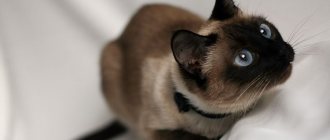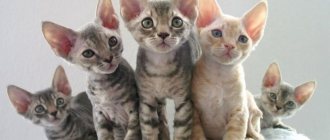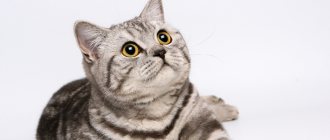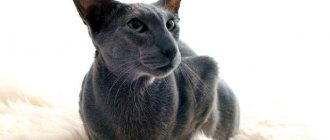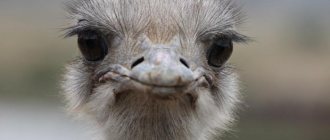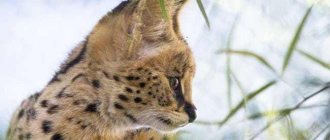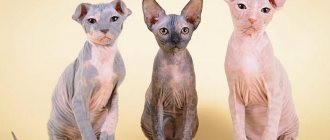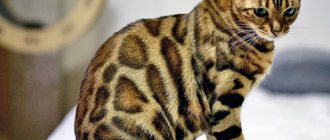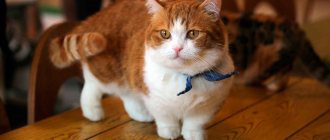Cats with big ears certainly cause affection among many lovers of these animals. Breeds of long-eared cats mostly take their roots from the hot tropics. Their natural function is thermoregulation of the entire body, and not an increase in hearing acuity, as it might seem. In the north, on the contrary, cats, dogs and other animals have small ears. But this does not prevent them from noticing danger or potential dinner within a few kilometers.
When choosing a cat, you can look at thin breeds whose ears seem large compared to the proportions of the body.
Domestic cat breeds with big ears
Many pets have wonderful and large ears. Their most prominent representatives.
Siamese cats
This ancient breed of pets is characterized by a triangular muzzle with an oriental cut of bright blue eyes and large, pointed, wide and oblique ears. The characteristic color is color-point in various colors.
Those with a noisy and restless temperament are strongly attached to their owner and are very talkative.
Widely distributed and affordable. In Russia, a pet-class kitten can be bought for five thousand rubles; purebred animals are much more expensive - up to sixty thousand.
Read more in the article about Siamese cats.
Balinese or Balinese cat
This is a semi-long-haired version of the Siamese. Similar to its relative in appearance, character and price of a kitten.
We wrote more in the article about the Balinese.
Abyssinian cat
This naturally formed breed was known back in Ancient Egypt. They bear the name of ancient Ethiopia (Abyssinia).
Wild, Sorel, Blue and Fawn are the main colors of the uniform ticked short coat. The remarkable large, widely spaced ears, according to some sources, previously ended in a tassel.
In character they are more reminiscent of a restless monkey. Widespread, you can buy a kitten for a price from ten to fifty thousand rubles.
Also read about Abyssinian cats and their long-haired variant, Somalia.
Somalia
This is an amazing long-haired variety of the Abyssinian. In character and appearance it is practically no different from its relative. The price for such a kitten is slightly lower.
Orientals
These cats do not conquer everyone with their appearance and character. But the huge ears leave no one indifferent.
The breed was bred from the Siamese. This sophisticated athlete with short hair without undercoat, a triangular head with huge ears protruding from the sides, resembles a bat or a space alien.
They do not tolerate cold well and are quite capricious in their care. The cost of a kitten is about twenty to sixty thousand rubles, depending on the class of the animal.
Read more in the article about the Oriental cat.
Cornish Rex and Devon Rex
A variety of breeds with short curly hair, huge eyes and prominent ears set low on the sides of the head. Nose with a break.
Cornish Rex
Devon Rex
They are very attached to people, kind and playful. You can buy a kitten for a price ranging from fifteen to fifty thousand rubles.
Sphinxes
A large group of hairless cats, including Canadian, Don and Petersburg (Peterbald) Sphynxes. Read the article about all types of the Sphinx breed.
Canadian Sphynx
The Canadian is the earliest breed, over fifty years old. With minimal differences, all these animals are characterized by a warm, pleasant to the touch velvety body with many folds on the skin. They are almost always completely hairless.
Don Sphynx
The head is large in relation to the body with almond-shaped eyes and prominent ears.
Peterbald
Prices for kittens depend on many factors and lie in a very wide range from ten to seventy thousand rubles.
Elf
Also applies to hairless breeds. Obtained by crossing the American Curl and the Canadian Sphynx. Possessing the characteristic features of the latter, including large expressive ears.
A rare and expensive animal worth from one to five thousand dollars, depending on the class of the kitten.
Read more in the article about Elves.
Ukrainian Levkoy
This hairless cat gets its name from its oddly shaped ears—large, soft, and folded forward at the tips. But there are also straight-eared individuals.
The price for a kitten is about twenty thousand rubles.
You can learn more from the article about Ukrainian Levkoys.
Maine Coon
A natural, very large, long-haired hybrid with large ears ending in a tassel - a lynx-like animal. There is a legend that they originated from the wild North American lynx.
Quite calm animals with a bunch of severe hereditary diseases. Despite this, they are very popular. The cost of the animal is from thirty to seventy thousand rubles.
More interesting information about Maine Coons on the Mister Cat portal.
Turkish Angora
It is surprising that these long-haired snow-white beauties with angelic blue or multi-colored eyes have very large ears and are not from the East. Very popular, widespread, affordable price - from ten thousand rubles.
Read more in the article about Turkish Angoras.
Kanaani or Canaani
People from the biblical area of Canaan. The breed is experimental, leopard color and wild type. The excretion contains the blood of wild and domestic cats. The breed is very young and quite expensive due to its rarity. Prices start from thousands of euros.
Serengeti
Outwardly they are somewhat reminiscent of Savannah, but much smaller. This is not a hybrid, obtained through selection of various domestic breeds. The ears are very similar to the Serval shells. Price from thirty thousand rubles.
Read more in the article about the Serengeti.
Poodlecat
An amazing breed bred in Germany with long wavy hair. Obtained by natural mutation of natural genes. Long ears can be straight or curved - hanging. Few in number and little known, these animals do not exist in Russia.
Toyger
This breed has gone quite far from its ancestor - the Bengal. But it is still more correct to classify it as a hybrid animal. Usually much larger than the Bengal, instead of the leopard color it has brindle - there are bright black stripes on the body. The price of a kitten is from forty to one hundred thousand rubles.
Read the article about Toygers.
Devon Rex and Gherkin Rex
The Devon Rex breed, bred in England, quickly conquered the world. The cats have a nice short, slightly curled coat, with huge ears sometimes topped with tufts.
Expert opinion
Slanimsky Alexey Georgievich
Veterinarian of the highest qualification category. Has extensive experience in diagnosing and treating diseases in animals.
You are unlikely to find a more loyal cat than the Devon Rex. Cats of this breed are very smart, easily learn commands, and cases have been recorded of Devon Rex protecting their owners.
In their behavior, Devons and Cornishes are the epitome of aristocracy: they do not steal food from the table, they are instantly litter-trained, they are as clean as possible, they are not vengeful and do not bite. They can be easily walked on a leash and experience virtually no stress when traveling or moving.
Hybrid cats with big ears
Breeds bred by humans from wild cats are hybrid. Among them there are also many cats with big ears.
The Savannah breed originated from the long-eared Serval by crossing with the Abyssinian. She is the largest to date (in the first generation) and is still very rare, while the cat almost completely repeats the appearance of the Serval (longer tail and slightly smaller ears). Very rare and expensive, both to acquire and to maintain.
Savannah
The hybridization of the House with the Abyssinian gave rise to the wonderful Chausie breed, whose appearance is slightly reminiscent of the Caracal. The coat is plain, ticked in colors sorel (red), natural (gray), black grizzly (black with gray hairs), completely black. Quite difficult to reproduce, rare and expensive, but very beautiful breed with large ears ending in a characteristic tassel (not always).
Chausie
The crossing of the Caracal with the Abyssinian cat was finally crowned with success and gave humanity the Caracat breed. Almost no different in appearance from their wild ancestor. Large, very beautiful and quite socialized animals. Work on the breed is still in full swing. Roads and rare.
Caraquet
Savannah
The breed was obtained by crossing a Serval and a Siamese cat and was registered only in 1996.
Representatives of the breed are distinguished by great intelligence and intelligence, they are easy to train and are able to remember several commands. The character is very playful and sociable, the cat does not tolerate loneliness. The Savannah has a long maturation period; it will take about three years for the character to be fully formed.
Useful video
All about the domestic serval:
Types of wild cats with large ears
The record holder for the largest ear size among the cat species living in the wild is the African Serval.
Serval
This is a medium-sized cat, up to 65 cm high at the withers and up to 1.5 m long from the nose to the tip of the short tail. Bright, almost orange in color (the intensity of the main tone depends on the subspecies) with black spots, white belly, quills and false “eyes” on the back of the ears. The predator's ears are truly outstanding in size, more than 5 cm, set high and vertical. Due to the high and slender paws and small head with a long and muscular body, it gives the impression of a very graceful creature. Although he is more of an athlete. Lives mostly in Africa.
Recently, it has become fashionable and status-bearing to keep an exotic cat in the house. To do this, the kittens are taken away from the breeding female early and hand-fed. The domestic Serval is a unique and wonderful, very beautiful pet. But few can afford to own such a cat - the price of an animal starts from half a million rubles. Keeping and caring for a pet is also not cheap.
Another wild beauty is Caracal. This is a separate species of cat, common in Asia, Dagestan, and China. Sometimes it is called the steppe lynx, but this is morphologically incorrect; it is more close to pumas.
Caracal
Slightly lower than the Serval, but more powerful and wider. The coat ranges from pale red to bright cherry color, and the eyes are often bright blue, surrounded by a black rim. The abdomen, quills and false “eyes” on the ears are white. The ears are very large with high black tufts. Just like the Serval, it is expensive to purchase and maintain.
Another big-eared cat predator is the much smaller Sandy or Dune cat. This savage is even smaller than a pet. Body length up to 90 cm, half of which is on the tail. The maximum weight of a male is 3.5 kg.
Dune cats
The coat is thick, soft, sandy, sometimes gray. The head is large, flattened, with thick sideburns. The ears on such a small animal seem simply huge - they are located widely and extend onto the side of the skull. They are reminiscent of such “locators” and the piercing gaze of the green eyes of space aliens. It lives in the Sahara, the Arabian Peninsula and Central Asia. This desert animal has an absolutely wild disposition and is absolutely not suitable for domestication.
An animal that very little is known about is the Chinese or Gobi desert cat. This species is endemic to China.
Gobi desert cat
Thick reddish skin with sparse stripes and thick soft hair visually increases the size of this small animal. The maximum weight of males is about 9 kg. The length with the tail is a little more than 90 cm, the height at the withers is 30. The ears of this steppe inhabitant are very large with expressive tassels reminiscent of lynxes.
These amazing creatures have been exterminated for a long time and intensively, today their population is less than ten thousand heads. They are listed in the second appendix of CITES - the convention on international trade. They are protected today by the Republic of China. Not social animals, there was no case of domestication.
The amazing animal Margay or Long-tailed cat lives in the tropical forests of South America. A bright, beautiful, medium-sized (up to 8 kg) representative of the leopard coloring, extremely rare and protected by the international community. The animal's ears are large, widely spaced, the tips almost do not narrow and are smoothly rounded.
Margay
Serengeti
A new and still expensive cat breed was officially registered only in 1994, but does not yet have the status to participate in exhibitions. Despite the fact that the name is similar to the wild serval, the breed was obtained by crossing a spotted oriental cat with a Bengal cat.
The cat's vocabulary is incredibly rich - she will follow the owner's heels and purr, sing, and click. It is worth considering the increased activity and some aggressiveness of the breed. They need to hunt and will do this by attacking their legs and arms. They are very active, stubborn and demanding.
Ukrainian Levkoy
These cats are descendants of the Sphynx and have rather large ears, which are located on the top of the head and can be curled or point straight up. These graceful animals have a gentle disposition, do not remember evil and do not like loneliness. But pets require special care: the body must be wiped with warm water, and if irritation or peeling occurs, use creams and lotions.
The price of Levkoy kittens depends on their appearance (low-eared, straight-eared), gender and class and ranges from 5,000-20,000 rubles.
Reasons for non-standard appearance
The leadership in the largest ears among all cat breeds belongs to cats of oriental breeds. It's all about the hot climate. It is no coincidence that nature endowed these animals with large hearing organs. With their help, effective heat exchange occurs. Cats' ears have very thin skin that is visible through. The entire auricle is penetrated by many tiny blood capillaries. The larger the ear size, the faster the blood cools and spreads throughout the body. For clarity, you can even compare the function of large ears with the operation of an air conditioner.
Canadian Sphynx
The oldest breed of cats, the hero of many legends. The Sphinx is an informal figure in the cat world. There is no fur or arrogance in this pet. Nature was original and did not divide cat qualities equally. However, the sphinx apparently was her favorite, since he inherited the best character traits.
Canadian Sphynx
The bald creature does not particularly resemble a cat, but in temperament is completely similar to a dog. The lack of fur is complemented by a “faceted” muzzle with an extremely philosophical expression and large ears.
These cats require special care. Lack of fur does not relieve owners from responsibility. Such a cat needs to be fed well. The owner's daily responsibilities also include cleaning the pet's skin and, in cold weather, dressing the cat in clothes.
Kanaani
Kanaani is a small cat whose descendants included the Bengal, Abyssinian, Libyan Steppe and domestic Murka.
Animals of this breed have a wonderful spotted color, slightly reminiscent of leopard patterns. Kanaani's physique is neat and proportional. Murka's legs are long, like its tail, its body is elongated, and its head is small. The ears are deep, set high, and very mobile.
Caring for these cats is easy. Their fur is short, which does not cause any trouble. And the food is similar to other cat favorites. The only strict necessity for the Kanaani is regular walks. The hunting instinct for this cat is part of her furry life.
Why big?
Some breeds of eared cats were obtained thanks to the long and hard work of breeders. But still, most of these cats have ancestors who live in hot countries, for example, Africa. Large ears in such a climate are a device for comfortable living.
The fact is that there are a large number of blood vessels on the surface of the skin of the ears. The blood, passing through such a vast surface of the capillaries, cools. Thus, long-eared cats can easily withstand the heat.
Eared record holders
Abyssinian
The Abyssinian was and will be one of the brightest eared record holders. Beautiful and strong, this cat remains cheerful in any weather. Thanks to huge locators, Murka feels good even in the most exhausting heat.
Abyssinian
Not many cats can boast such an original appearance. The Abyssinian breed is distinguished by its oriental “shroud” coloring, strong build and cat-like “makeup” - black eyeliner. The exterior is complemented by the famous ears: wide-set and large.
The cat itself is strong and muscular, its legs are long, its paws are neat. A special feature of the Abyssinian is the absolute inability to remain in place for more than a minute. This is a lively pet, active and playful.
Somalia
Descendant of the Abyssinian breed. Murka has medium-length fur, neat shape and, of course, beautiful ears.
The Somali cat is a real beauty. Her main “trump card” is a luxurious fur coat. This fur is reddish. A special feature of the fur coat is ticking (each fur has stripes of a different shade). The unusual color is complemented by a chic collar and wonderful pants. The whole outfit creates an extremely elegant image of a domestic predator.
In addition to the “suit,” the cat is distinguished by a neat physique and graceful gait. The Somali cat is the embodiment of grace and charm. And her character is so versatile and delightful that having met such a cat, you can hardly resist falling in love.
Oriental cat breed
Oriental cats are special. This applies to both appearance and character. This Murka comes from the east. Having become the progenitor of many modern cat breeds, the Oriental is a representative of the most remarkable qualities that nature could endow with independent cats.
This is a very friendly breed. The devotion of Orientals is legendary. Many people compare the temperament of these cats to that of a dog. And for good reason. Having chosen an owner, the oriental cat will be faithful to him in any matter.
Oriental cats have a bright appearance. Many people underestimate the exterior of these cats, considering them too clumsy in appearance. And in vain. The elongated body of the Oriental is very flexible and graceful. Long limbs are dexterous like a cat.
Eared Oriental
The ears of the Oriental deserve special attention. The breed standard clearly outlines the traits that should be present in the locators of a purebred cat. The ears should be pointed, triangular, and their line should continue the line of the cheekbones.
Devon Rex
The eared record holder is the Devon Rex. The first thing that catches your eye when looking at this pet is its ears. They are really huge. The wide base of the shell ends in a rounded tip. The ears are set relatively close to each other, but due to their size, the locators look almost to the sides.
Devon rex
The Devon Rex is often compared to a feline alien. He is so different from other cats. In addition to prominent ears, the Rex has large, expressive eyes. The “smile” complements the already curious mustachioed muzzle.
These cats come in a wide variety of colors. However, there is relatively little wool itself. At some time these cats can be almost hairless. Later, the fur coat grows back with a vengeance.
Health
The health of the Javanese cat is vulnerable and requires constant attention. Diseases include heart disease, asthma, neurosis, strabismus, and digestive problems. Some individuals inherit diseases. Be sure to take your pet to an appointment with a veterinarian: he will determine the necessary vaccinations and the timing of their administration; regular visits will help maintain the pet’s health throughout its life.
If you notice that the cat’s usual activity has decreased, the cat has begun to eat poorly, avoids its usual company, discharge has appeared from the eyes, ears, mouth, and digestion has been disturbed - do not self-medicate, contact the veterinarian unscheduled and as early as possible.
Care
Caring for a Javanese cat consists of the following procedures:
- brushing the pet. Once a week is enough because the Javanese coat has no undercoat. Use a soft comb, do not tug at the fur, and use slow, light strokes from roots to ends.
- weekly cleaning of teeth and ears with special products,
— you don’t have to bathe your cat often, once a month or a month and a half is enough. Use special mild shampoos, and after washing, wrap the cat and release it to a warm place without drafts.
- maintaining eye hygiene.
- trimming nails. Do this yourself, removing no more than two millimeters of claws with sharp forceps, or contact a specialist to carry out the procedure correctly.
— Javanese can be taken for walks on a leash or harness; it is only important to avoid contact with other animals to avoid injury and contracting diseases.
Maine Coon
Maine Coons are giants in the world of domestic cats. These are massive animals, with thick, luxurious fur coats and a strong build. The weight of an adult cat can reach up to 15 kilograms. But don’t think that Coon is an aggressive predator. Every kilogram of the pet is filled with patience and calmness. This is a wonderful pet.
In addition to their luxurious fur, Maine Coons have a memorable face, the zest of which is, of course, added by the ears. The cat's locators are located at the very top of the head. They are pointed and pointing upward. The tips of the ears are decorated with wonderful tassels.
Maine Coon
Maine Coon in the house - the end of peace. This pet's antics never stop. However, they are practically harmless and cause trouble. These cats are friendly and loyal.
How to choose a kitten
When choosing a kitten, you should carefully examine it: its eyes and ears should be clean, its teeth should be white, and the baby should not show anxiety when its tummy is touched. Pay attention to the activity of the javanese - the cat must be active and play.
Check your pet's hearing – it is among Javanese cats that kittens with hearing impairments are often born. Suitable age for purchase is 3-4 months. Such a cat will easily get used to its new home and owners, and it will be easier for you to establish contact.
If you decide to have offspring with a Javanese, try to choose your partner carefully. The animal must meet all accepted parameters, have no congenital or genetic diseases, and be vaccinated. The age of cats is at least 2 years, males - 1.5 years.
Mating of Javanese is carried out in the place where the cat lives. Try to ensure that the cat brings kittens no more often than once every 1.5-2 years, otherwise the animal itself will weaken, which will negatively affect the offspring.
The Javanese cat is a devoted, loving creature; with proper care and feeding, the pet can live up to 15 years, delighting you with affection and purring.
